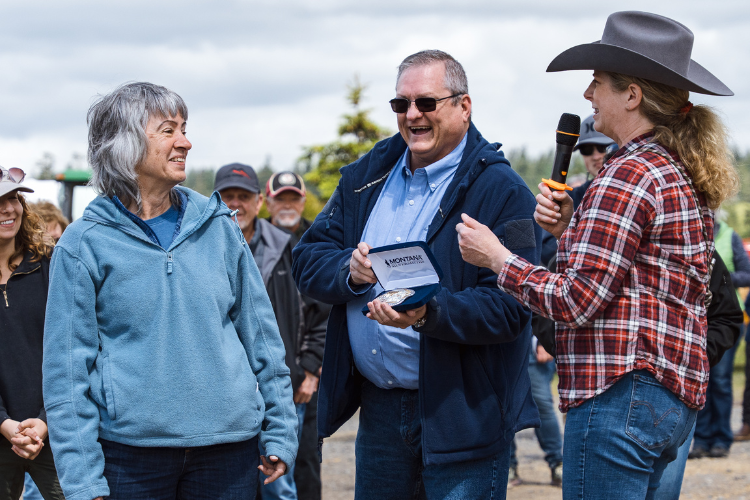Long-Term Viability Of Agriculture In Thurston County
posted on
April 24, 2025

Thurston County is updating its comprehensive plan, which lays out policies for future land use, housing, economic development, and natural resource protection for the next 20 years. My family arrived in Thurston County even before the county was established, and we are deeply about the future of the county, and our community.
For more than 170 years, we have been stewards of the land while providing high-quality beef to the community. Today, our ranch is protected by a conservation easement to ensure that it will remain in agriculture forever. But that is not the case for the majority of our agricultural lands in Thurston County.
Agricultural lands face pressure from development as our population grows. They face challenges related to economic viability, which often results in land being sold for other uses besides agriculture. And they face regulatory burdens that can make this challenging work untenable.
The long-term preservation of our agricultural lands is important not just to provide our community with the benefit of a strong local food system, but for all of the other benefits these lands provide to our community as well.
Less than 3% of our native prairies remain in this area, and many of them are located on working agricultural lands where native plants essential for threatened and endangered butterflies are thriving.
Agriculture lands provide critical wildlife habitat for endangered species such as the Mazama pocket gopher. Our ranch, as one example, is also home to a range of wildlife including elk, deer, cougar, bear, bald eagles, rare birds such as the white-breasted nuthatch, and dozens more.
In addition, agricultural lands provide other benefits to the community, including environmental benefits such as carbon sequestration and flood control, as well as opportunities for recreation and agritourism, and the intangible beauty of scenic open spaces and dark night skies.
The county has made efforts to conserve and enhance agricultural lands that have been deemed to have long-term commercial significance. However, the county’s definition of those lands leaves out a significant portion of our most important agricultural resources.
The criteria used to designate agricultural land of long-term commercial significance are primarily based on soil type, with designed lands including predominately prime farmland soils for producing crops.
But crops are not the only agricultural product that provide economic value and feed our community. Pastureland accounts for 29% of the county’s agricultural lands, and much of this pastureland is located on prairie soils. According to the 2022 USDA Census of Agriculture, the total value of agricultural products sold in Thurston County is over $190 million, with 79% of that attributed to livestock and poultry, and just 21% attributed to crops.
Thurston County prairies provide some of the best agricultural lands for grazing, but they would never be considered prime farmland with the best soil and growing conditions for producing crops. Our prairie soils are rocky glacial outwash and nutrient-poor, but they are home to native and endangered species that have evolved over tens of thousands of years to thrive in this specific soil type. As a result, these lands create the best conditions for producing the highest-quality grass-finished beef, even if crops would never do well in these soils.
Parcel size is another criteria, stating that land must be at least 20 acres to be eligible for agricultural designation. Our ranch, for example, is comprised of 10 parcels ranging from 1.5 acres to 209 acres, with only four parcels including more than 20 acres. Taken together, these parcels total more than 500 acres, but considered as individual parcels, they would be too small to support a viable agriculture business.
Agricultural diversity is another requirement for designating agricultural land of long-term commercial significance, stating that there should be a variety of agricultural activities in designated areas. Again, this would exclude the pastureland located on prairie soils not suited for other types of agriculture. The several thousand acres of land around Colvin Ranch support grazing as the only viable agricultural activity. These lands have long-term agricultural value, even if they do not support growing a variety of crops.
Additional criteria for identifying the agricultural lands that are critical for supporting other types of agriculture should be considered. For example, agricultural lands that are protected by conservation easements and can only be used for agriculture should be considered as well.
If the goal is to ensure a strong agriculture industry in Thurston County, to preserve and buffer agricultural lands from more intense uses that could encroach or cause permanent damage, to foster traditional rural lifestyles, and to minimize potential conflicts and reduce unnecessary conversion of farmland, then it is necessary to consider all types of agriculture, not just the production of crops.
If you would like to comment on the county's update to the comprehensive plan, you can attend the public hearing on April 26 at the Thurston County Atrium from 10:00 am - 2:00 pm. You can also attend via Zoom, or submit a written comment to Thurston2045@co.thurston.wa.us. More information is available on the Thuston 2045 website.



